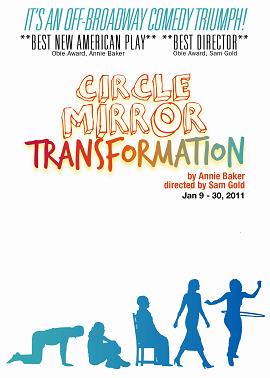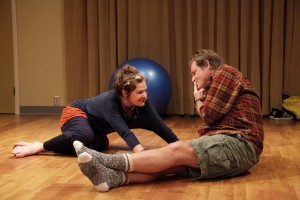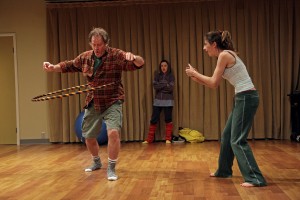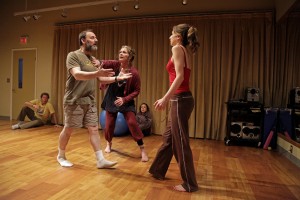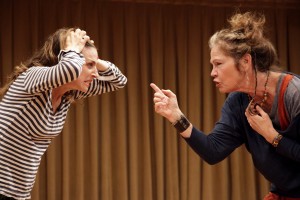GAMES PEOPLE PLAY
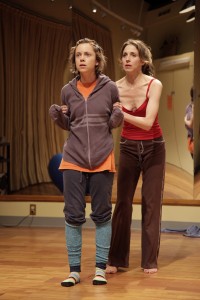 Sometimes a play comes along that is so different from any play that has preceded it that, while it may have people scratching their heads, wondering what it is they have just seen – or even dismissing it out of hand because of its unfamiliarity – it is exactly the kind of play that demands our attention. Such a play is Annie Baker’s Circle Mirror Transformation. It comes at us looking and feeling like no other play, and provides us with the unexpected pleasure of witnessing something brand new. Where does this come from? What other plays informed it? Or inspired it? Only one thing is clear: it was designed to take place in a theater, not on any big or small screen. Since too much theater seems to emerge from theater practitioners meeting each other – time and again – in the same theater lobbies and talking about how to duplicate the success of last season, they lose the sense of adventure without which progress in the theater becomes nearly impossible. These people love the theater in their way, but they live too much in the theater and begin to lose touch with life. So plays begin to look alike. And then a play like Ms. Baker’s comes along and both confounds and delights us, if we are open to the sensation of hearing a strange but beautiful new voice, a voice that is trying to locate where the contemporary mind dwells.
Sometimes a play comes along that is so different from any play that has preceded it that, while it may have people scratching their heads, wondering what it is they have just seen – or even dismissing it out of hand because of its unfamiliarity – it is exactly the kind of play that demands our attention. Such a play is Annie Baker’s Circle Mirror Transformation. It comes at us looking and feeling like no other play, and provides us with the unexpected pleasure of witnessing something brand new. Where does this come from? What other plays informed it? Or inspired it? Only one thing is clear: it was designed to take place in a theater, not on any big or small screen. Since too much theater seems to emerge from theater practitioners meeting each other – time and again – in the same theater lobbies and talking about how to duplicate the success of last season, they lose the sense of adventure without which progress in the theater becomes nearly impossible. These people love the theater in their way, but they live too much in the theater and begin to lose touch with life. So plays begin to look alike. And then a play like Ms. Baker’s comes along and both confounds and delights us, if we are open to the sensation of hearing a strange but beautiful new voice, a voice that is trying to locate where the contemporary mind dwells.
Briefly, the play wants to capture, in less than two hours, the experience of taking a six-week course in creative drama somewhere in rural Vermont. If that sounds restrictive, it is only as restrictive as the experience itself. Yes, it consists merely of exercises. And there are rest periods and cigarette breaks and chances to get to know each other, but real connection seems problematic, because, after all, the possibility of connection is so tied into the raison d’etre of the class that it almost works against itself, as anyone who has ever been in any self-help environment will tell you.
And though Ms. Baker works in broad strokes in creating her five characters, the final image we have of them is almost pointillist in its accuracy. Without many words, and in an atmosphere that represses real emotional involvement even as it encourages it, so much gets said about who these people are that it feels practically Chekhovian, even though these people don’t sit around and talk endlessly about the failure of their lives. It’s because people, as a rule, don’t do that sort of thing anymore. They sputter, burst forward and shut down, reach out and withdraw. They know a lot, these people do, but they express what they know in a pure state of tentativeness. It is possible that we find out more about them than they find out about themselves. But isn’t that true of all great art? Isn’t it true of Chekhov?
It was T.S. Eliot who, in The Cocktail Party, decided that, because the family, as a unit, was beginning to fall apart, a psychiatrist’s office was the perfect setting for the modern play. Harold Pinter turned the family unit into a house of strangers. Ms. Baker seems to have taken a hard look at her own times and decided upon a neutral place like a school gym where strangers meet to express their deepest feelings and express instead the monotonous jargon of theater games. And yet, as Ms. Baker suggests, something – some little nugget of enlightenment that resembles the truth – emerges. It may just be tiny revelations that don’t seem to add up to much, but the revelations may support the potential for growth. When, at the end, two of her characters anticipate their futures, it actually feels as if they have learned something. How interesting it is to see a play that ends not happily, but reassuringly.
In a play like this, the director’s contribution is as significant as the author’s, forging effectively a style as fresh as the play’s concept. Sam Gold has done a remarkable job, encouraging his design team to create the perfect environment, and getting, from his actors, a dream ensemble. David Zinn’s gym is not merely neutral, it is almost antiseptic. Leah Gelpe’s sound design is sharp yet understated. Mark Barton’s lighting design is simple and right on target. The cast – Linda Gehringer as an acerbic teacher, Brian Kerwin as her estranged husband, Arye Gross as a recently divorced man looking for a way out of his loneliness, Marin Hinkle as the one person who might eventually become an actress, Lily Holleman as the student who would like to make herself invisible and who also asks the hardest questions – couldn’t be better. The pauses the play takes fill the room with a poignant sense of passing time. And there’s a giant blue ball that manages to do something so miraculous, one expects the ball to take a curtain call.
I don’t know how or even if the future of the theater will look to Circle Mirror Transformation for inspiration; but it is here, right now, and it’s unlike anything but its own pure self. That should be reward enough for anyone who takes theater seriously.
photos by Scott Brinegar/SCR
Circle Mirror Transformation
South Coast Repertory, 655 Town Center Drive in Costa Mesa
Tues-Fri at 7:45; Sat & Sun at 2 and 7:45
ends on January 30, 2011
for tickets, call 714.708.5555 or visit SCR
